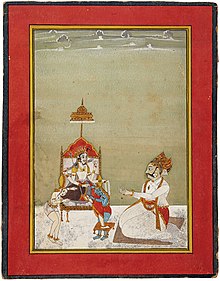|
Gaj Singh of Bikaner
Maharaja Gaj Singh was the ruler of the Kingdom of Bikaner between 1746 and 1787. During this period, the Kingdom was a vassal state of the Mughal empire.  BiographyGaj Singh was born in 1723. He was the son of Anand Singh, and the cousin of his predecessor Zorawar Singh. Zorawar had died childless, and the claimants to the throne were Gaj and his brother Anand Singh. In 1746, Gaj was enthroned, and Amar defected to Jodhpur. The Maharaja of Jodhpur, Abhai Singh allying himself with Amar Singh, sent a large force which invaded Bikaner and encamped outside the city. The Bikaner army had anticipated the invasion, and had prepared accordingly. However, no decisive battle was fought and the armies remained in a standoff for many months. The Maharaja of Jodhpur proposed a division of Bikaner's territory, and this was rejected by Gaj. Finally, in 1747, the two armies engaged in battle with Gaj leading the troops himself, and the invading army was defeated. Upon hearing this, Abhai Singh dispatched a second army against Bikaner, which was defeated at Didwana.[1][2] Abhai Singh of Jodhpur died in 1749 and was succeeded by his son Ram Singh. Ram Singh ruled for two years before he was defeated by the combined forces of Bakht Singh and Gaj Singh of Bikaner. Bakht was enthroned and subsequently, Gaj returned to Bikaner. He entered Jodhpur again soon after, to assist Bakht against an invading force led by Ram Singh. This force was defeated, and Gaj returned to Bikaner a second time. However, Bakht Singh died in 1752 and Gaj recognized his son Vijay Singh as the ruler of Jodhpur, according him support.[3] Gaj proceeded with his forces to assist Vijay Singh, who was facing the combined forces of Ram Singh and the Marathas. The armies clashed first at Gangarada, and later at Chorasan, and the armies of Gaj and Vijay Singh were defeated. Gaj Singh hosted Vijay Singh at Bikaner, and later the two went to Jaipur in order to solicit aid from the Maharaja Madho Singh. Madho Singh, however, was allied to Ram Singh, and offered 84 villages to Gaj in exchange for allying himself with Ram Singh. This offer was rejected by Gaj.[4] In 1752, the Mughal emperor Ahmad Shah assigned the pargana of Hisar to Gaj, as Mughal forces were unable to keep it under control. On Gaj Singh's behalf, Mehta Bakhtawar Singh occupied it. Mehta aided the emperor against the vizier Mansur Ali Khan, and for this assistance, Gaj Singh was granted a mansab of 7000 zat and 5000 horse in 1753. Later, Gaj was also granted the right to mint currency by the Mughal emperor Alamgir II.[5][6] Rebellion of Raj Singh and deathSubsequently, the heir apparent Raj Singh along with other Thakurs of the state rose in rebellion. The prince lived at Deshnoke between 1775 and 1780, after which he took shelter at Jodhpur, where he was received by the Maharaja Bijay Singh. Bijay advised the prince to return to Bikaner along with a small contingent. Upon their arrival however, Raj Singh was arrested by his brothers. However, when Gaj fell ill, he summoned Raj Singh and handed over the reins of the state to him, enjoining him not to seek vengeance against his brothers. Gaj Singh died in 1787, and was cremated.[7][8] IssueGaj Singh had sixty-one children, of whom six were legitimate. These included:
References
Bibliography
|
||||||||||||||||||||||
Portal di Ensiklopedia Dunia
